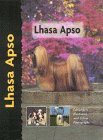
Lhasa Apso
Lhasa Apsos were originally kept in Tibetan monasteries, where they were used as watchdogs. They look very similar to Shih Tzu, with their short legs, long shaggy coats and tails carried upwards curling over their backs - some people call both breeds 'mop dogs'. They do have different characters, however, the Lhasa Apso being calmer, more aloof and dignified, taking their time to get to know strangers.
Both breeds can be strong willed, so patience is needed when training them. The Lhasa Apso is more of a challenge to train, and more effort needs to be put into training bite inhibition, since untrained Lhasa Apsos can be a bit nippy. They were used as watchdogs, so being wary of strangers, and biting them occasionally was not seen as such a bad thing! Both breeds are a little small for households with younger children, who may want to pick them up clumsily, since they are such cuddly-looking dogs.
Lhasa Apsos are somewhat less tolerant of children, or defend themselves better, depending on how you look at it, so they are not really suitable for households with young children. They can get on well with older children who respect them, and they are an active breed which enjoys exercise with children. Lhasa Apsos can get on well with other dogs, though some other dogs can find their untrimmed appearance a bit of a shock.
This is one breed which needs very careful training as a pup, especially if there are children in the household. Don't be misled by their looking small and cute - they can inflict damage with their little fangs if you overindulge them, and let them playbite. They need to learn early on that biting people is against your rules, and they need to have house rules set out clearly from puppyhood. It helps to bring children into the training programme so that they are able to make the dog obey them, and the dog receives consistent commands. It's also important to get your little mop dog used to being groomed and handled by dog-savvy friends before you inflict him on a groomer. Otherwise you may find that your groomer is suddenly fully booked every time you try to make an appointment!
It's really kinder to trim their coats, unless you plan to show them, otherwise they collect mud on walks, need a lot of grooming and cleaning, and find it difficult to see. Lhasa Apsos can tolerate cold well, because of their thick coats, but need protection from the sun in summer, when they should go out for walks in the early morning or evening, rather than in the heat of the day. They need regular walks, or some sort of off leash outdoor activity, and can easily get bored if they spend too much time cooped up in the home.
They aren't especially barky as a breed, so aren't likely to annoy the neighbours unless they are bored, and bark from boredom. They do like company, and aren't happy at being alone all day. This breed is well suited to an older person who has experience of strong-willed dogs, and wants a dog with character, which is not strong enough to pull them over. They will act as excellent watchdogs, tending to bark at strangers. This bark is surprisingly loud, so they can provide some security for an older person living alone, by frightening away potential intruders with their bark.
Common Lhasa Apso health problems include back, kidney and eye trouble, and hip dysplasia has also been reported. Lhasa Apsos tend not to be as long-lived as Shih Tzu, but they usually age well, staying active even when they are seniors.
Juliette Cunliffe's book is very well illustrated, and goes into the background of this breed in great detail. There are chapters on grooming and health as well as feeding and breeding. She has personal experience of the breed, having years of experience as an owner and breeder of Lhasa Apso dogs.



